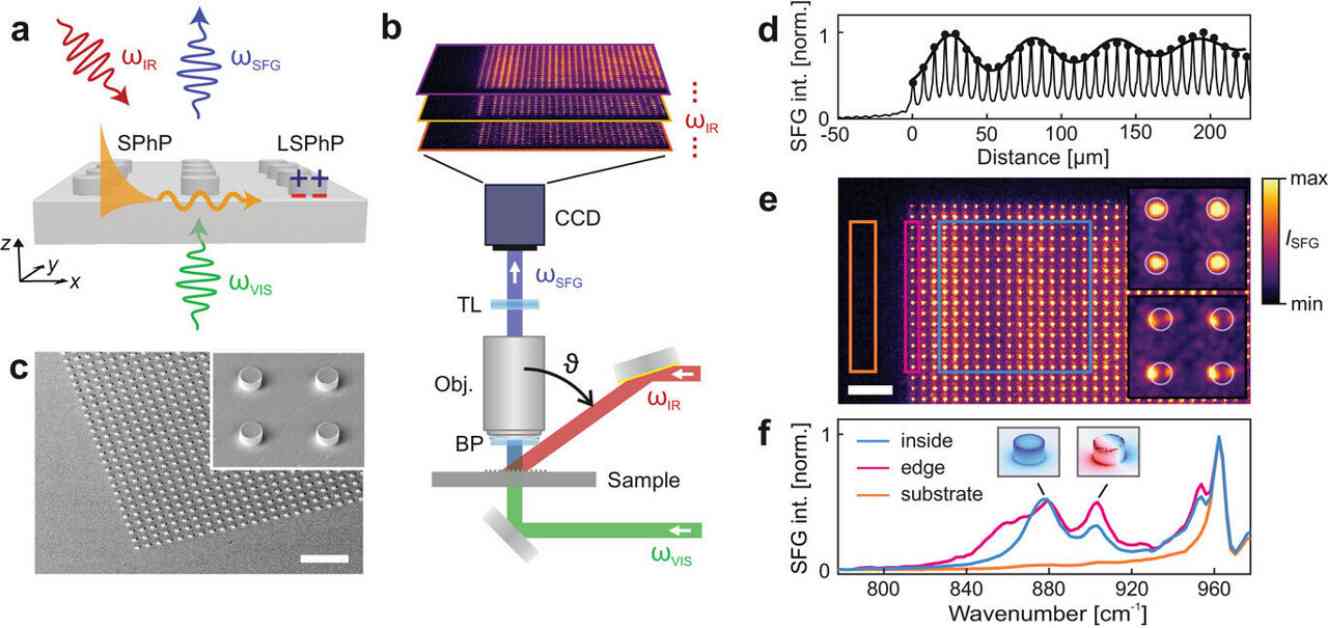Scientists at the Department of Physical Chemistry at the Fritz Haber Institute of the Max Planck Society have achieved a groundbreaking discovery in the realm of nanotechnology, as outlined in their recent publication in Advanced Materials. Their study, titled “Spectroscopic and Interferometric Sum-Frequency Imaging of Strongly Coupled Phonon Polaritons in SiC Metasurfaces,” introduces an innovative microscopy technique that enables the visualization of nanostructures and their optical properties in ways previously thought impossible.
Metamaterials, meticulously engineered at the nanoscale, possess unique characteristics not present in naturally occurring materials. These exceptional properties stem from their minute building blocks, which, due to their diminutive size, have proven challenging to observe directly because they are smaller than the wavelength of light. Yet, the team of researchers has surpassed this obstacle by employing a novel microscopy method capable of simultaneously unveiling both the nano and macro structures of these materials.
The crux of this research lies in a methodological breakthrough that allows for the visualization of structures that were once too minuscule to be discerned with conventional microscopy techniques. By harnessing light in innovative ways, the scientists have managed to confine one color of light within the structure, while mixing it with a second color that can exit the structure, thereby allowing for the visualization of this trapped light. This breakthrough has unveiled the concealed world of nanoscale optical metamaterials.
This significant achievement is the culmination of over five years of dedicated research and development, leveraging the unique capabilities of the Free Electron Laser (FEL) at the Fritz Haber Institute. This type of microscopy is particularly remarkable because it offers a deeper comprehension of metasurfaces, laying the groundwork for advancements in technologies such as lens design, with the ultimate aim of producing flatter, more efficient optical devices.
Enhancing the understanding of metasurfaces through this research paves the way for the development of innovative light sources and the design of coherent thermal light sources. The research team notes, “We are only scratching the surface, but the implications of our work for the field of flat optics and beyond are immense. Our technique not only allows us to observe the complete performance of these nanostructures but also to enhance them, reducing 3D optics to 2D, and streamlining everything to be smaller and flatter.”
The study, led by Richarda Niemann et al, has been published in Advanced Materials in 2024, with the DOI: 10.1002/adma.202312507. This research not only sheds light on the hidden world of nanoscale optical metamaterials but also lays the foundation for future advancements in the field of optics and beyond.
Implications for Metasurfaces
The research conducted by the team at the Fritz Haber Institute has far-reaching implications for the field of metasurfaces. By employing advanced microscopy methods to visualize nanostructures and their optical properties, the scientists have unlocked new possibilities for the development of cutting-edge technologies. Metasurfaces, known for their ability to manipulate light at the nanoscale, are crucial components in the design of various optical devices.
Advancements in Flat Optics
One of the key outcomes of this research is the advancement of flat optics technology. By gaining a deeper understanding of metasurfaces and their optical properties, researchers can now explore the potential of creating flatter, more efficient optical devices. This breakthrough could revolutionize the field of optics, leading to the development of next-generation optical components with enhanced performance and reduced dimensions.
Future Directions in Nanotechnology
The innovative microscopy technique developed by the team at the Fritz Haber Institute opens up new avenues for research in the field of nanotechnology. By visualizing nanostructures with unprecedented clarity, scientists can now delve deeper into the world of nanoscale materials and their unique properties. This research lays the groundwork for future advancements in nanotechnology, with the potential to drive innovation across various industries.
In conclusion, the groundbreaking research conducted by the team at the Fritz Haber Institute has unveiled a hidden world of nanoscale optical metamaterials, offering new insights into the realm of nanotechnology. By pushing the boundaries of conventional microscopy techniques, the scientists have paved the way for advancements in flat optics, metasurfaces, and beyond. The implications of this research are vast, with the potential to revolutionize the field of optics and drive innovation in nanotechnology for years to come.













